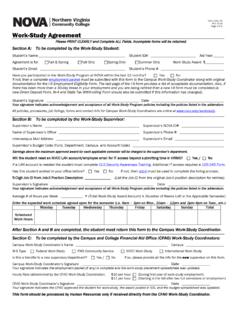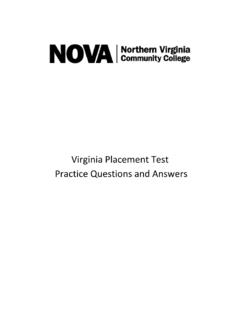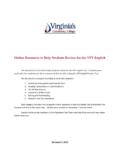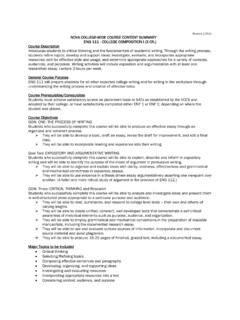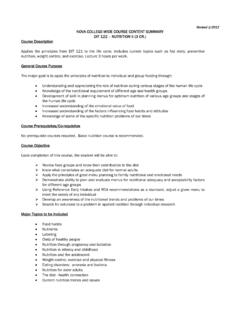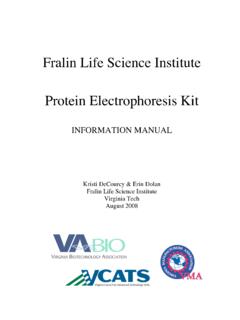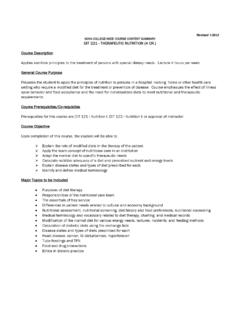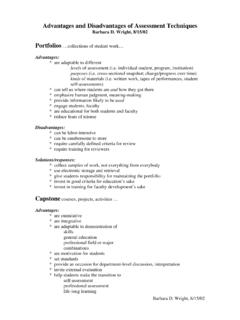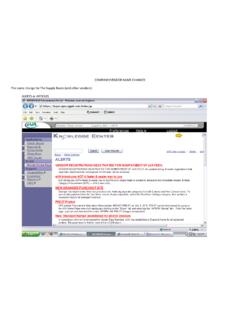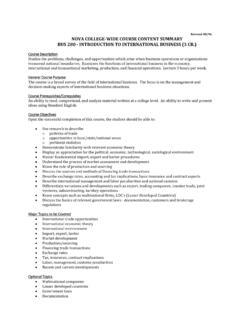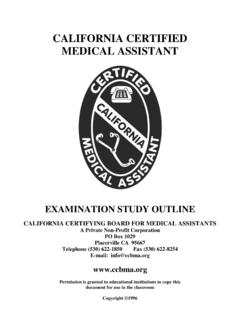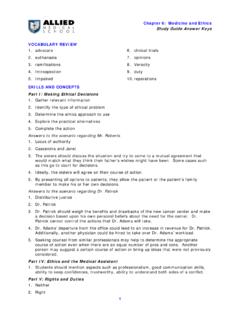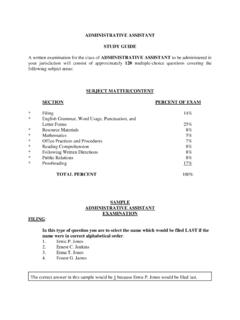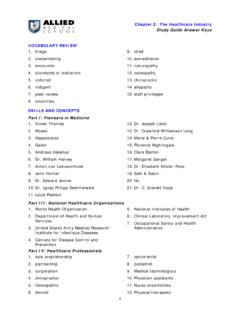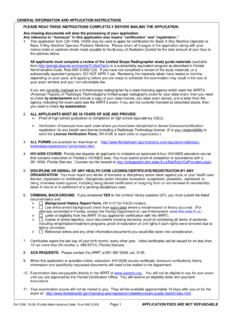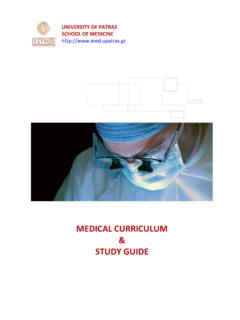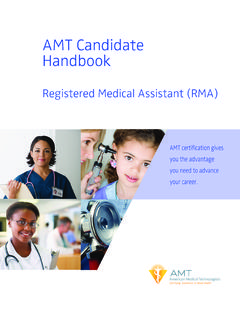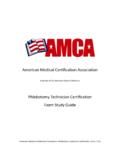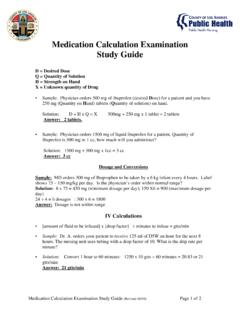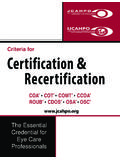Transcription of Certified Clinical Medical Assistant Student Handbook
1 2014 Certified Clinical Medical Assistant Student Handbook Program Philosophy The NOVA WDD Certified Clinical Medical Assistant (CCMA) faculty supports the mission and vision statements of the college as well as a commitment to life-long learning and a belief in educational mobility and accessibility. NOVA WDD CCMA Program believes in establishing a collaborative and supportive learning environment through developing Student -faculty relationships which are based on trust and mutual respect. Medical Assistant faculty believes that learning is an active process that is facilitated by role-modeling and encompassing the students in a variety of Clinical , classroom and simulated settings.
2 Learning is further enhanced by the use of a variety of teaching methods to accommodate different learning styles and actively engage the Student in the teaching/learning process. Medical Assistant Program believes that students and faculty are responsible for the outcomes of learning. Medical Assistant education and the practice of Medical assisting are based upon an understanding of the human person which is learned in general education courses. The Student Medical Assistant builds upon this knowledge in Medical assisting theory and utilizes problem solving to apply concepts and facts to Medical Assistant practice in varied Clinical and laboratory settings.
3 We believe in providing planned Medical Assistant experiences to enable the students to achieve learning outcomes and develop Clinical competence. Course Description This program prepares Medical Assistant students to perform patient Clinical skills in various Medical office settings. students perform Clinical procedures including administering medications, assisting with minor surgery, performing an electrocardiogram, obtaining laboratory specimens for testing, educating patients, and maintaining Clinical equipment in an ambulatory care setting. Medical assistants perform routine Clinical tasks to keep the offices of physicians, podiatrists, chiropractors, and optometrists running smoothly.
4 Clinical duties may include taking Medical histories and recording vital signs, explaining treat-ment procedures to patients, preparing patients for examination, and assisting the physician during the examination. Medical assistants collect and prepare laboratory specimens or perform basic laboratory tests on the premises. They instruct patients about medication and special diets, prepare and administer medications as directed by a physician, authorize drug refills as directed, telephone prescriptions to a pharmacy, draw blood, prepare patients for x-rays, take electrocardiograms, and change dressings. Note: This program will provide the necessary training and skills required to challenge the National Healthcareer Association (NHA) Certified Clinical Medical Assistant (CCMA) national examination.
5 This program includes classroom lecture and hands on labs. The Clinical Medical Assisting program is laid out in three sections: Clinical Medical Assisting Section: Lessons #1-#14 covers the Clinical Medical Assisting section provides students with the knowledge and skills related to the Medical office duties of the Medical Assistant . The Clinical Medical Assisting textbook is used for this section. The chapters on EKG and phlebotomy concepts are eliminated. EKG Section: Lessons #15 - #23 covers the specific knowledge and skills related to cardiovascular anatomy and physiology and performance of a 12-lead EKG test. students learn how to accurately place leads onto the patient, run the EKG machine, perform basic measurements using the EKG strip, and identify normal tracings of the heart s electrical activity as well as identify common dysrhythmias.
6 A separate EKG textbook and workbook is used for this section of the course. Lab Services and Phlebotomy Section: Lessons #24 - #40 provides the Student with knowledge and skills related to collecting specimens for lab services including hematology, urinology, and other tests performed on body fluids. students learn to perform a venipuncture procedure on adult, pediatric, and geriatric patients. A separate phlebotomy textbook and workbook is used for this section of the course. Course Objectives Upon completion of the CCMA Program, the graduate will be qualified and proficient in the following.
7 Explain the Medical Assistant s role in patient-centered care in various types of Medical offices Describe how to prepare the office for a patient encounter Explain the concepts of Medical and surgical asepsis Explain basic principles of pharmacology including how to administer various types of medication Explain how to measure vital signs Discuss how to help the physician in minor surgery including the identification of surgical supplies and equipment and maintaining a sterile field Explain effective communication strategies Explain the concepts of infection control, patient safety, OSHA blood borne pathogen standards, and body mechanics Demonstrate how to initiate, maintain, and discontinue a peripheral IV on a practice arm Discuss how a Medical Assistant can assist in a Medical emergency Discuss how a Medical Assistant can assist the physician in the following Medical specialties.
8 Ophthalmology and otolaryngology, dermatology, gastroenterology, urology and male reproduction, obstetrics and gynecology, pediatrics, orthopedic medicine, neurology and mental health, endocrinology, pulmonary medicine, cardiology, and geriatrics Discuss how a Medical Assistant should provide instruction in diagnostic procedures such as with diagnostic imaging, analysis of urine, phlebotomy, analysis of blood, and microbiology Demonstrate effective handwashing technique for the Medical environment Demonstrate use of personal protective equipment in the Medical environment Explain how to measure a patient for axillary crutches and how to instruct patients in their use Explain how to perform a surgical hand scrub and how to apply and remove sterile gloves Explain how to open a sterile pack Apply the basic electrophysiologic principles of cardiac conduction to the anatomy and physiology of the body Identify proper placement of leads to ensure an accurate and consistent EKG reading Evaluate various EKG rhythm strips
9 Following established normal criteria for each of the wave forms and intervals Analyze a variety of EKG rhythm strips, identifying rate, rhythm and intervals Analyze a variety of EKG rhythm strips for common dysrhythmias Perform a 12-lead EKG test Explain the steps in selected specimen collection procedures performed by the phlebotomy technician Explain the safety procedures in performing specimen collection procedures Identify specific supplies and equipment used in selected specimen collection procedures Explain precautions and guidelines when collecting specimens in special populations such as pediatrics and geriatrics Define quality of care and explain the impact on patient Medical care when quality and safety are compromised in phlebotomy
10 Procedures Perform a venipuncture on a variety of patient types. Sit for the NHA CCMA National Exam Pregnant Student Policy It is expected that a pregnant Student notify the instructor as soon as pregnancy is confirmed for the welfare and safety of the Student . Pregnant students may continue in the program with written physician approval, a signed acknowledgment of the potential risks involved, and perhaps permission of the Clinical agency involved. These requirements should be completed as soon as possible. Please call (703) 450-2551 and request a Declaration of Pregnancy Form. In conference with the course instructor, be made aware of the potential risks associated with Clinical studies while pregnant.
